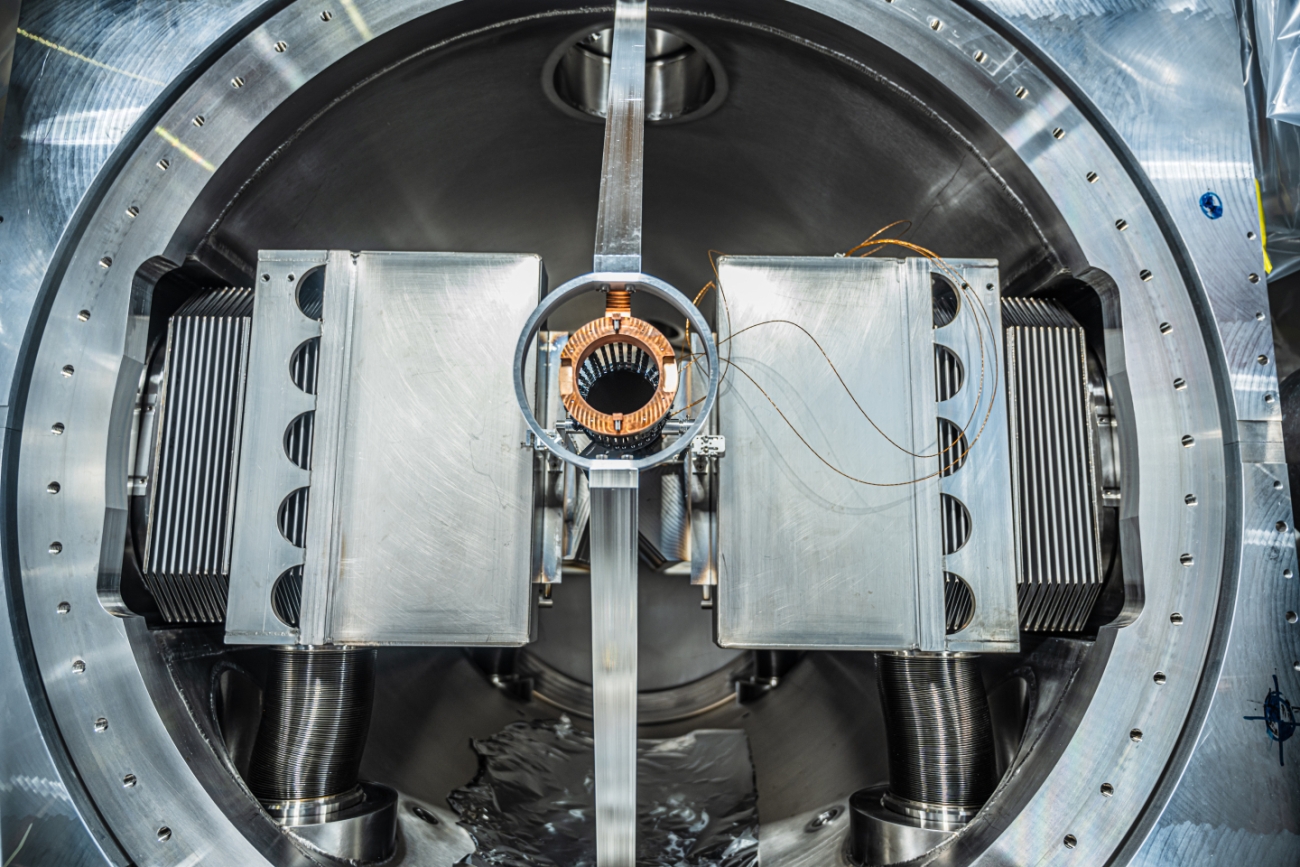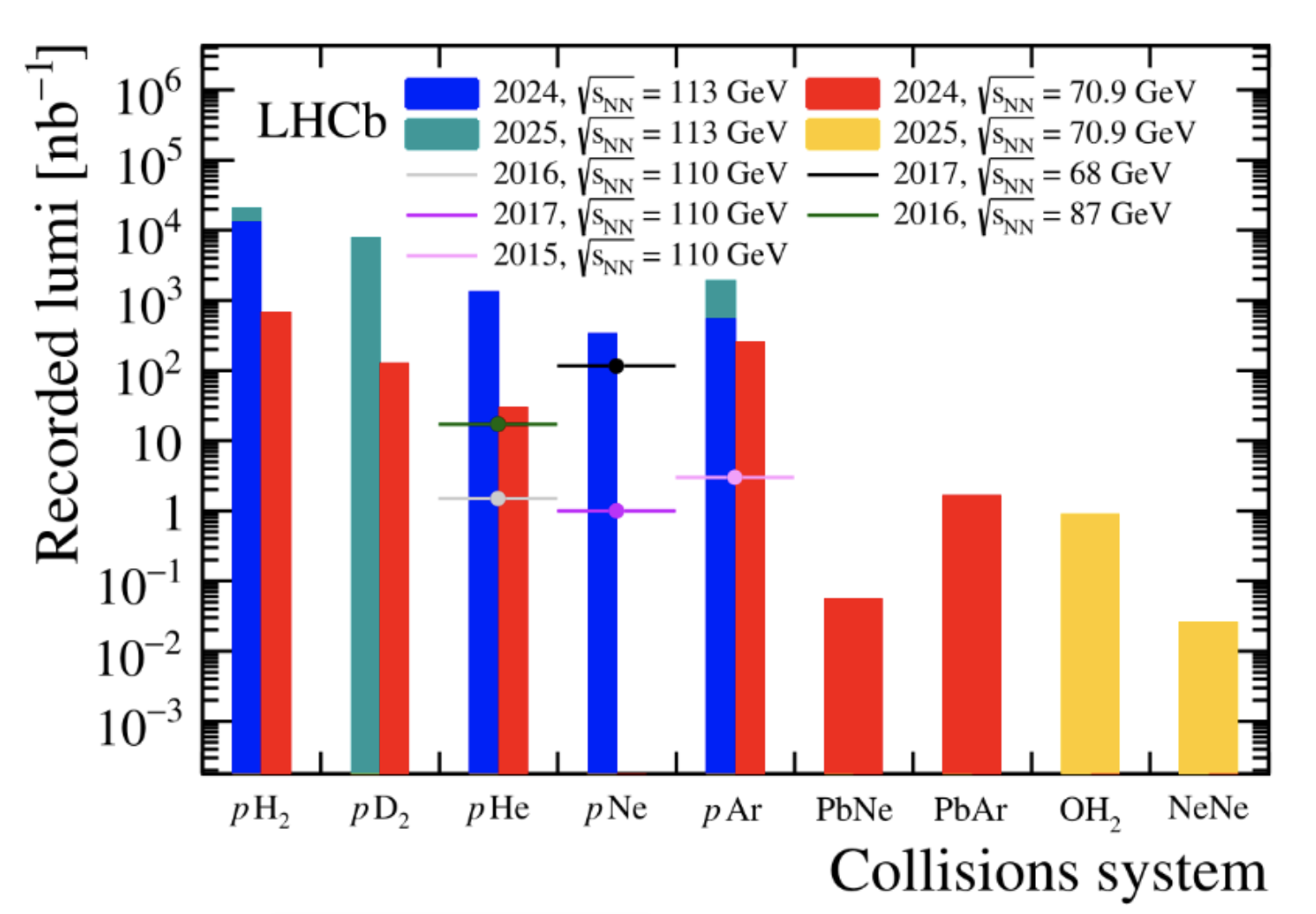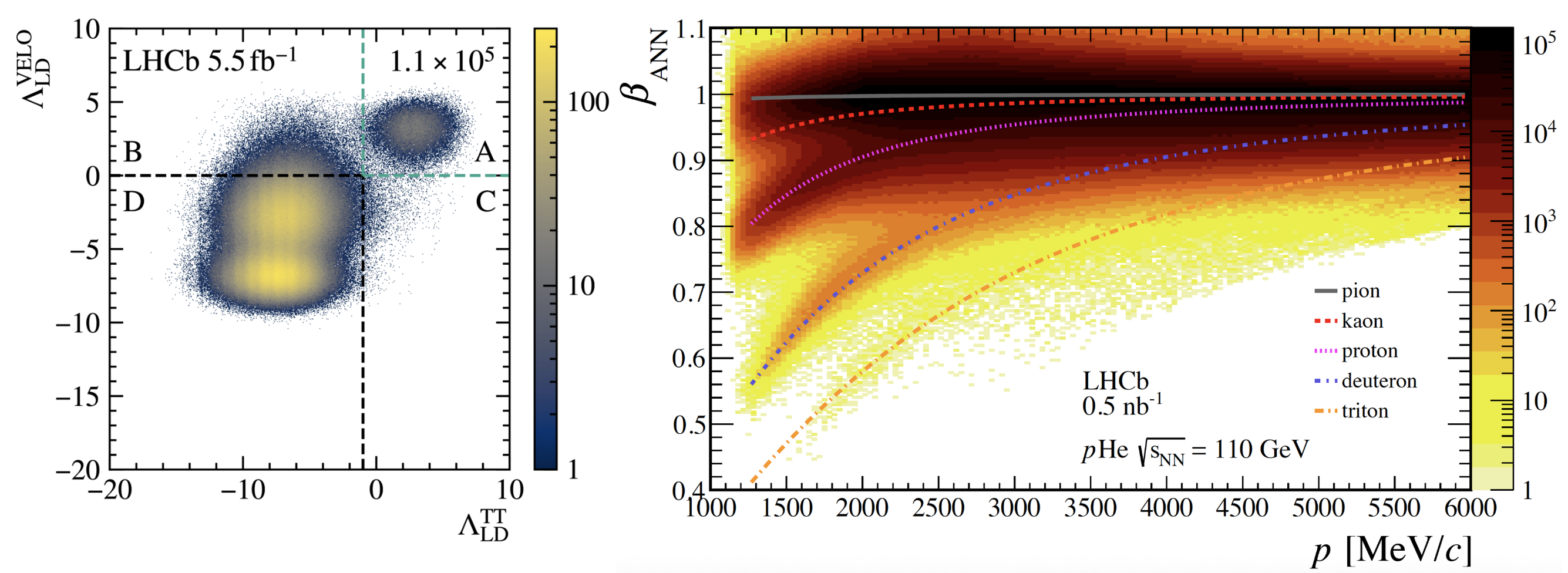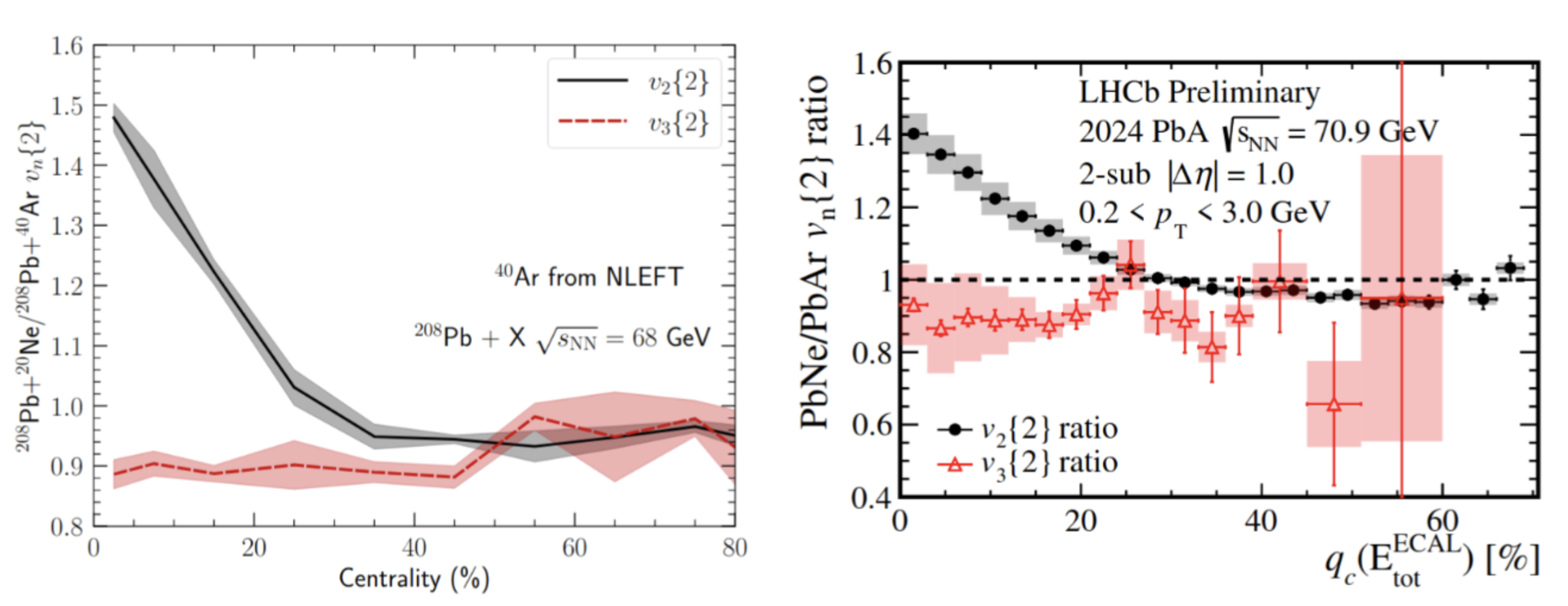SMOG(2) at LHCb: a space experiment and a bowling alley

A famous aphorism, sometimes attributed to Max Planck, goes “When you change the way you look at things, the things you look at change". Since 2011, the LHCb experiment at the LHC has employed a System for Measuring Overlap with Gas (SMOG) to inject gas in the accelerator beam-pipe, and improve the measurement of the collected luminosity [Nucl. Instrum. Meth. A553 (2005) 388]. By exploiting the available gas target, combined with the forward geometry of the LHCb detector and its excellent performance, LHCb with SMOG has been operated since 2015 as the highest-energy fixed-target experiment ever. While initially injecting in the vessel of the innermost LHCb detector, the VELO, with a corresponding gas pressure of about 10-7 mbar, a dedicated storage cell for the gas, SMOG2, is now installed at the upgraded LHCb, covering a (44 ± 10) cm-wide region upstream of the nominal interaction point. The much lower SMOG2 conductance with respect to the VELO vessel is such that a x100 pressure is now available compared to the Run 2 system. Moreover, the SMOG2 cell detachment from the LHCb interaction point, combined with the software-only data acquisition and event-reconstruction framework LHCb adopted for its upgrade [Comput.Softw.Big Sci. 4 (2020) 1, 7], enables LHCb, since 2024, to continuously operate with two independent and simultaneous interaction points [Phys. Rev. Acc. Beams 27 (2024) 111001]. As shown in Fig.1, the resulting luminosities with the combined 2024 and 2025 data-taking years outperform the Run 2 ones by orders of magnitude. The diversity of the collected samples, combined with a nucleon-nucleon centre-of-mass energy range √sNN poorly explored by previous facilities, make the physics prospects unique, as summarised e.g. in LHCb-PUB-2018-015]. Two recently published examples, exploiting SMOG(2) as a space experiment or as a bowling alley, are discussed below.
Since the beginning of its operations, the SMOG system has demonstrated to be particularly suitable to perform measurements of interest for the astroparticle community, reproducing the configuration of a cosmic ray impinging on the interstellar medium (ISM, approximately 90% H2 and 10% He) or on the Earth’s atmosphere. The cross-sections for antimatter production in pH2 and pHe collisions, in particular, are extremely relevant for Dark Matter searches by space-borne experiments, which look at antimatter excesses in cosmic rays with respect to the expectations from cosmic rays collisions on the ISM. While the experimental precision of the data from space has largely improved through the years, their conclusive interpretation is still limited by the precision of the description of these background processes' production cross-section [arXiv:2503.16173]

Fig. 1: Collected luminosities in 2024 and 2025 with the SMOG2 system compared with the final ones from the SMOG Run 2 operations (considering for them a 0.8 m-wide region as fiducial for the gas).
By injecting helium, hydrogen or deuterium with SMOG(2), a long research programme to shed light on the cosmic antimatter production has started. LHCb first published the primary [Phys. Rev. Lett. 121 (2018) 222001] and from-strange secondary [Eur. Phys. J. C83 (2023) 543] antiproton component in pHe collision, both being the first measurements ever in that system. The search has now moved towards light anti-nuclei, golden channels for indirect Dark Matter detection as impossible to produce in known primary sources and suppressed in their production in cosmic rays - ISM interactions. In order to perform such studies, the particle identification capabilities of the LHCb experiment have been expanded through the development of two new complementary techniques. As shown in left Fig. 2, by exploiting the ionisation losses in the silicon sensors of the tracking detectors, helium nuclei candidates are isolated in pp collisions [JINST 19 (2024) P02010]. On the other side, deuteron and triton candidates are successfully identified in pHe collisions by profiting from the time-of-flight capability of the Runs 1 and 2 LHCb detector [arXiv:2508.06305], as illustrated in right Fig. 2. These two complementary approaches employed on the SMOG data samples will provide comprehensive results on nuclei and antinuclei production in the fixed-target LHCb configuration.

Fig. 2: Left: distribution of the silicon-trackers-based estimators for helium candidates in pp data, with the signal region denoted by A. Right: estimated velocity versus momentum for reconstructed tracks in the pHe collision sample, with the expected evolutions for different hadron species, including deuteron and tritons, overlaid.
A second recently published result compares instead the collective behaviour of the emitted particles in the 2024 PbNe and PbAr collision data. While the lead and argon nuclei are predicted to be spherical, a bowling-pin-like shape with 4+1 alpha clusters is expected for the neon [Phys. Rev. Lett. 135 (2025) 012302, Phys. Rev. Lett. 134 (2025) 082301]. In this case, SMOG2 provides us bowling or lawn balls alleys for PbNe and PbAr collisions, respectively. For central ion collisions, the geometry of the overlap region is resolved and is expected to have an effect on how particles are collectively produced. This is shown in left Fig. 3, presenting the ratio between the elliptic and triangular flow coefficients, quantifying how elongated and triaxial the final-state particles emission is, in PbNe and PbAr collisions. For central collisions, the bowling-pin neon is expected to show an approximately 1.5 larger v2 with respect to PbAr, resulting from its more elongated shape. The preliminary results of the measurement [LHCb-CONF-2025-001], shown on the right of Fig. 3, confirms the expectations: a larger elongation of neon with respect to argon, and a similar triangularity. These results, complemented by those that are being studied by LHCb and other LHC collaborations on the OO and NeNe collisions delivered in July 2025, are consistent with the expected peculiar shape of the neon nucleus, and confirm the major impact the initial state geometry has on the collective expansion of the medium.

Fig. 3: Comparison of the ratio of the elliptic and triangular flow coefficients between PbNe and PbAr collisions, according to (left) theory and (right) the preliminary results of a recently published measurement based on 2024 PbNe and PbAr data.
In conclusion, LHCb is pioneering since the LHC Run 2 fixed-target physics at the available highest energy, starting from 2022 with a dedicated interaction point to beam-gas collisions. Such a facility is unique under different aspects: its phase-space coverage and energy, poorly explored by previous experiments, the variety of the colliding systems it enables and, as a consequence, the physics prospects it offers. These also include research fields where LHC results were not initially foreseen to contribute, such as astrophysics or nuclear shape analysis. By changing our perspective when looking at LHC collisions, LHCb with SMOG can hence also appear as a space experiment and a bowling alley.
Further reading
[1] Nucl. Instrum. Meth. A553 (2005) 388 — DOI
[2] Comput. Softw. Big Sci. 4 (2020) 1, 7 — DOI
[3] Phys. Rev. Accel. Beams 27 (2024) 111001 — DOI
[4] LHCb-PUB-2018-015 — LHCb fixed-target physics prospects
[5] arXiv:2503.16173 — Antimatter production cross-sections in pHe / pH collisions
[6] Phys. Rev. Lett. 121 (2018) 222001 — DOI
[7] Eur. Phys. J. C 83 (2023) 543 — DOI
[8] JINST 19 (2024) P02010 — DOI
[9] arXiv:2508.06305 — Deuteron and triton reconstruction in pHe collisions
[10] Phys. Rev. Lett. 135 (2025) 012302 — DOI
[11] Phys. Rev. Lett. 134 (2025) 082301 — DOI
[12] LHCb-CONF-2025-001 — Results for PbNe vs PbAr flow coefficients
